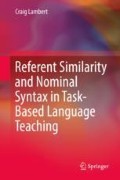Abstract
This chapter describes the design of an empirical study of the effects of referent similarity on the speech of L1 and L2 speakers of English. The chapter outlines the purpose of the study, the experimental design employed, background information concerning the participants, the tasks used to collect the data, and the data collection and analysis procedures employed. The aim throughout is to provide a sound basis for the replication of the study, in whole or in part, in future research. The following chapter will discuss the findings for referent similarity on English use.
Access this chapter
Tax calculation will be finalised at checkout
Purchases are for personal use only
References
Coltheart, M. (1981). The MRC psycholinguistics database. Quarterly Journal of Experimental Psychology, 33A, 497–505.
Diessel, H., & Tomasello, M. (2005). A new look at the acquisition of relative clauses. Language, 81, 882–906.
Educational Testing Service. (2008). TOEIC test data and analysis 2007: Number of examinees and scores in FY2007. Tokyo: The Institute for International Business Corporation, TOEIC Steering Committee.
Ellis, R., & Barkhuizen, G. (2005). Analyzing learner language. Oxford, UK: Oxford University Press.
Ford, W., & Olson, D. (1975). The elaboration of the noun phrase in children’s descriptions of objects. Journal of Experimental Child Psychology, 19, 371–382.
Kennedy, C. (2006). Modes of comparison. Proceeding of CLS, 43.
Lambert, C., Kormos, J., & Minn, D. (2017). Task repetition and second language speech processing. Studies in Second Language Acquisition, 39, 167–196.
Long, M. (2015). Second language acquisition and task-based language teaching. Oxford, UK: Wiley Blackwell.
MacWhinney, B. (2001). The competition model: The input, the context, and the brain. In P. Robinson (Ed.), Cognition and second language instruction (pp. 69–90). Cambridge, UK: Cambridge University Press.
Meara, P. (2005a). Llama_D: A test of phonetic memory. Retrieved March, 2012, from http://www.lognostics.co.uk/tools/llama/
Meara, P. (2005b). Llama_F: A test of grammatical inferencing. Retrieved March, 2012, from http://www.lognostics.co.uk/tools/llama/
Meara, P. (2005c). LLAMA language aptitude tests: The manual. Retrieved March, 2012, from http://www.lognostics.co.uk/tools/llama/
Ravid, D., & Berman, R. (2010). Developing noun phrase complexity at school age: A text-embedded cross-linguistic analysis. First Language, 30, 3–26.
Robinson, P. (2011a). Task-based language learning: A review of the issues. Language Learning, 61(Suppl. 1), 1–36.
Robinson, P. (2011b). Second language task complexity, the cognition hypothesis, language learning and performance. In P. Robinson (Ed.), Second language task complexity: Researching the cognition hypothesis of language learning and performance (pp. 3–37). Amsterdam: John Benjamins.
Sapir, E. (1944). Grading, a study in semantics. Philosophy of Science, 11, 93–116.
Schmid, M., Verspoor, M., & MacWhinney, B. (2011). Coding and extracting data. In M. Verspoor, K. de Bot, & W. Lowie (Eds.), A dynamic approach to second language development: Methods and techniques (pp. 39–54). Amsterdam: John Benjamins.
Service, E. (1992). Phonology, working memory & foreign language learning. Quarterly Journal of Experimental Psychology, 45a, 21–50.
Service, E., & Kahonen, V. (1995). Is the relationship between phonological memory and foreign language learning accounted for by vocabulary acquisition? Applied PsychoLinguistics, 16, 155–172.
Shuttleworth, M. (2009). Counterbalanced measures design. Retrieved November, 2011, from Experiment Resources: http://www.experiment-resources.com/cpimterbalanced-measures-design.html
Speciale, G., Ellis, N., & Bywater, T. (2004). Phonological sequence learning and short-term store capacity determine second language vocabulary acquisition. Applied PsychoLinguistics, 25, 293–321.
Yule, G. (1997). Referential communication tasks. Mahwah, NJ: Lawrence Erlbaum.
Author information
Authors and Affiliations
Rights and permissions
Copyright information
© 2019 Springer Nature Singapore Pte Ltd.
About this chapter
Cite this chapter
Lambert, C. (2019). Methods. In: Referent Similarity and Nominal Syntax in Task-Based Language Teaching. Springer, Singapore. https://doi.org/10.1007/978-981-13-3089-6_7
Download citation
DOI: https://doi.org/10.1007/978-981-13-3089-6_7
Published:
Publisher Name: Springer, Singapore
Print ISBN: 978-981-13-3088-9
Online ISBN: 978-981-13-3089-6
eBook Packages: Social SciencesSocial Sciences (R0)

